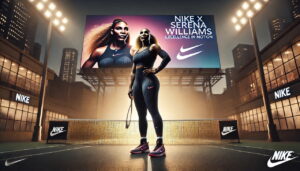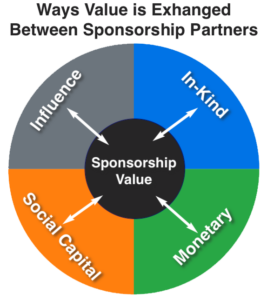Guide to Sponsorship Marketing: 7 Types of Sponsorship and How Value is Exchanged
Sponsorships offer a dynamic way for brands and properties to collaborate. They create mutually beneficial partnerships that can drive success. By leveraging various types of sponsorships, organizations can enhance their reach, build brand equity, and strengthen their reputations.
Whether you’re a property looking for financial support or a brand looking for heightened exposure, these strategies can provide a competitive advantage when you understand the different sponsorship strategies and how value is exchanged between partners.
What Is Sponsorship?
Sponsorship is a partnership in which one party provides financial or in-kind support to another in exchange for promotional opportunities and mutual benefits. It creates a platform for both participants to achieve their goals through shared resources and strategic collaboration.
How Do Sponsorships Work?
Sponsorships create a mutually beneficial partnership between a property, such as a team, event, venue, or athlete, and a brand sponsor. The sponsor provides support, often in the form of funding, products, or services, while the property offers promotional opportunities like brand exposure, audience access, or exclusive association.
This exchange of value allows sponsors to achieve their goals. These often include increased brand awareness, enhanced reputation, or improved engagement through sponsorship marketing.
Properties benefit by gaining the resources needed to achieve their objectives. A well-aligned sponsorship strategy allows both parties to maximize value and foster long-term partnerships that contribute to their respective success.
The 10 Goals of Brand Sponsorship
Parties that engage in sponsorships can have numerous goals for the relationship. Here are 10 of the most common.
- Increase Brand Awareness. A sponsorship allows brands to reach new and expanded audiences, thereby enhancing visibility through events, partnerships, and promotional marketing efforts.
- Build Brand Equity. Associating with reputable events or organizations reinforces a brand’s credibility and helps establish trust with target audiences.
- Enhance Audience Engagement. Sponsorships create direct audience interaction opportunities through experiential activations, exclusive offers, or shared experiences.
- Showcase Products or Services. In-kind sponsorships allow brands to provide products or services that align with the sponsored property, showcasing their value in real-world applications. This is often accomplished through brand placements at events or in media exposure.
- Strengthen Competitive Positioning. A thoughtful sponsorship strategy helps brands differentiate themselves from competitors by aligning with relevant values or unique events.
- Foster Positive Brand Perception. Supporting meaningful initiatives or events helps enhance a brand’s reputation and demonstrates social responsibility. A brand providing branded shirts for a local team signals support for local organizations.
- Generate Leads and Sales. Sponsorship marketing often includes targeted campaigns that drive sales, collect leads, or encourage customer loyalty through exclusive promotions.
- Create Long-Term Partnerships. Sponsorships can build lasting relationships with properties, audiences, and stakeholders, fostering future collaboration opportunities.
- Support Community Engagement. Cause-related sponsorships enable brands to connect with communities, promoting goodwill and meaningful social impact.
- Gain Media Exposure. Partnering with high-visibility properties can lead to media coverage, expanding a brand’s reach through organic promotion.
Sponsorship vs. Partnership — What’s the Difference?
Sponsorship and partnership involve collaboration between entities but differ in structure, focus, and value exchange.
- Sponsorship typically centers on one party (the sponsor) providing support — financial, in-kind, or otherwise — in exchange for promotional opportunities through the property’s resources. This could include branding, logo placements, or direct audience engagement. Sponsorships are often transactional, with a clearly defined goal for the sponsor to gain visibility or association with the property, such as a band, event, or organization.
- Partnerships, on the other hand, are more collaborative and comprehensive. While they may include sponsorship elements, partnerships involve a deeper, ongoing relationship in which both parties contribute resources, ideas, and efforts toward shared goals. Partnerships usually focus on long-term value creation, align more broadly with business objectives, and require significant collaboration and mutual input.
That said, sponsorship is a type of partnership. While partnerships encompass broader collaboration, sponsorship marketing is a more focused strategy within that scope, designed to create targeted promotional marketing opportunities and tangible benefits for both participants. Whether you pursue sponsorship, partnership, or both, the ultimate goal is to build a mutually beneficial relationship that drives success for all parties involved.
7 Types of Sponsorship
Every type of sponsorship provides unique opportunities for exposure, engagement, and growth. Here’s a look at seven popular types of sponsorships, how they work, and real-world examples that highlight their impact.
Event Sponsorship
Event sponsorship involves funding or supporting an event in exchange for promotional benefits, such as logo placement, naming rights, or on-site branding.

- Example: Heineken sponsors Coachella, an annual music and arts festival held in Indio, California. Heineken’s branding is visible across the festival grounds and engages directly with attendees through interactive experiences.
Sports Sponsorship
Sports sponsorship is among the most high-profile types of brand support for teams, leagues, or competitions. It allows sponsors to connect with passionate fan bases while gaining extensive media exposure.

- Example: Emirates sponsors Arsenal Football Club, featuring its logo on team jerseys and within the Emirates Stadium. This widely viewed exposure helps create a strong global presence.
Venue Sponsorship
Venue sponsorship grants a brand naming rights or exclusive advertising opportunities within a specific location. This often leads to long-term visibility and association with the property.

- Example: Crypto.com sponsors the former Staples Center in Los Angeles, now renamed Crypto.com Arena. These naming rights solidify its branding in a key entertainment hub.
Athlete or Celebrity Sponsorship
This type of sponsorship aligns a brand with a public figure and leverages their influence to reach specific audiences that follow the figure. It often involves endorsements, social media campaigns, or branded appearances.

- Example: Nike sponsors Serena Williams. The athletic shoe company creates ads and product lines that connect the brand with her excellence and global appeal.
Media Sponsorship
Media sponsorship involves a brand partnering with a media outlet to promote an event, property, or cause through advertising or editorial coverage. It provides extensive audience reach through established platforms.

- Example: Many local TV stations have sports and weather daily news segments sponsored by local brands in which logos are displayed and audio mentions are included.
Arts & Entertainment Sponsorship
This type of sponsorship supports cultural events, performances, or exhibitions. It allows brands to engage with creative communities and associate with artistic expression.

- Example: BMW sponsors Art Basel, aligning its brand with high-end art and connecting with an affluent, culture-driven audience.
Social or Cause-Related Sponsorship
Cause-related sponsorship supports initiatives or organizations focused on social impact, such as sustainability, health, or education. It demonstrates corporate responsibility while fostering goodwill.
- Example: Patagonia sponsors the “1% for the Planet” initiative, donating a percentage of sales to environmental nonprofits. The effort aligns with Patagonia’s sustainability mission.
Each of these types of sponsorships offers unique opportunities for brands to enhance their sponsorship marketing and achieve strategic goals. By selecting the right type, brands and properties can create valuable partnerships that resonate with their audiences while fostering mutual growth.
How Is Value Exchanged Between Sponsorship Values?
Sponsorships are built on the foundation of value exchange, where both the sponsor and the sponsored party (property) benefit from the partnership. Whether it’s monetary support, products, services, or promotional opportunities, each participant contributes resources that help achieve mutual goals. Here’s how value is exchanged through different types of sponsorships.

Monetary Backing
In a traditional sponsorship arrangement, the sponsor provides direct financial support in exchange for promotional benefits. The funding helps the sponsored property execute its events or projects while the sponsor gains visibility and audience engagement.
Budweiser’s sponsorship of the FIFA World Cup showcases its brand globally through event signage, commercials, and activations, while FIFA uses the funds to run the tournament.
In-Kind Sponsorship
Instead of cash, sponsors provide goods or services to meet the needs of the sponsored property. In-kind sponsorships reduce costs for the organizer and give sponsors an opportunity to showcase their offerings directly to the audience.

Delta Airlines partners with the Tribeca Film Festival and provides transportation for festival guests. Delta benefits from brand association with a cultural event, while Tribeca minimizes travel expenses.
Influencer Sponsorships
Influencer sponsorships involve collaborating with individuals with a dedicated following, usually in social media. It leverages their reach and trust to promote a brand or property. In return, influencers may receive monetary compensation, free products, or exclusive perks.
L’Oreal sponsors beauty influencers to promote its products on platforms like Instagram and YouTube. Influencers get paid or are given products, while L’Oreal increases its reach and connects directly with targeted audiences.
Cause-Related Sponsorships
In this arrangement, sponsors support social initiatives or charitable causes. The sponsored property gains critical funding or resources, while the sponsor demonstrates corporate social responsibility and builds social capital and goodwill among consumers.

REI’s #OptOutside campaign encourages outdoor activities by partnering with conservation groups. REI donates resources to these initiatives while aligning its brand with environmental sustainability.
Maximizing Sponsorship Value
The value exchange in sponsorship marketing hinges on alignment between the sponsor’s goals and the property’s needs. Sponsors seek visibility, engagement, and association with shared values, while properties leverage resources to execute their vision. Whether through monetary backing, in-kind sponsorship, influencer partnerships, or cause-related initiatives, a well-executed sponsorship strategy creates long-term benefits for both parties.
When you understand the types of sponsorships and tailor partnerships accordingly, brands and properties can build meaningful, results-driven collaborations.
Master Your Sponsorship Strategy
A successful sponsorship strategy requires careful planning, clear objectives, and measurable outcomes. To maximize the impact of sponsorship marketing, brands and properties focus on the following key steps:
1. Define Goals
Start by identifying what you want to achieve through sponsorship. Common goals include increasing brand awareness, boosting audience engagement, enhancing reputation, or supporting community initiatives.
2. Understand the Target Audience
Know who you’re trying to reach. Research demographics, interests, and behaviors to ensure alignment between the sponsorship and the audience. For example, a fitness brand might target health-conscious millennials through an athletic event.
3. Allocate Your Budget
Determine how much you’re willing to invest in the sponsorship. Include considerations for monetary support, in-kind sponsorship, and any additional promotional marketing costs required to maximize visibility.
4. Identify Potential Sponsorship Opportunities
Look for opportunities that align with your brand values and goals. For instance, a sustainable brand might explore partnerships with eco-friendly festivals or organizations.
5. Craft a Sponsorship Proposal
Develop a proposal tailored to the potential partner, highlighting mutual benefits. Include specifics on value exchange, such as audience reach, branding opportunities, or promotional collaboration.
6. Execute the Sponsorship Strategy with Appropriate Tactics
Implement the sponsorship by activating tactics like event branding, influencer partnerships, or exclusive promotions. For example, a tech company might showcase its latest product as part of a high-profile event partnership.
7. Measure and Evaluate Results
Use key performance indicators (KPIs) such as audience reach, engagement metrics, and return on investment (ROI) to assess the sponsorship’s success. Adjust future strategies based on insights gained.
By following these steps, brands and properties can create a focused sponsorship strategy that achieves their goals, connects with audiences, and delivers long-term value for all participants.
Evaluate Your Sponsorship Strategy Today with SponsorCX
Take your sponsorship strategy to the next level with expert guidance from SponsorCX. Whether you’re a brand looking to maximize visibility or a property seeking the right partners, our team can help you identify the best types of sponsorships to achieve your goals.
From sponsorship marketing to in-kind sponsorship opportunities, we can guide you to tailor strategies that align with your objectives and target audience. Don’t leave your success to chance.
Contact SponsorCX today for a personalized evaluation and discover how we can help you create impactful, results-driven partnerships. Let’s build a sponsorship strategy that delivers real value.











